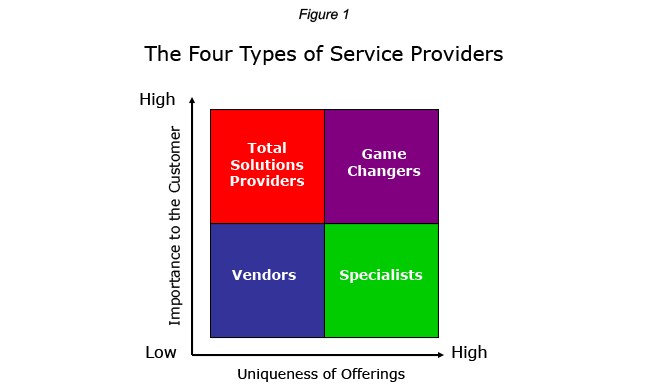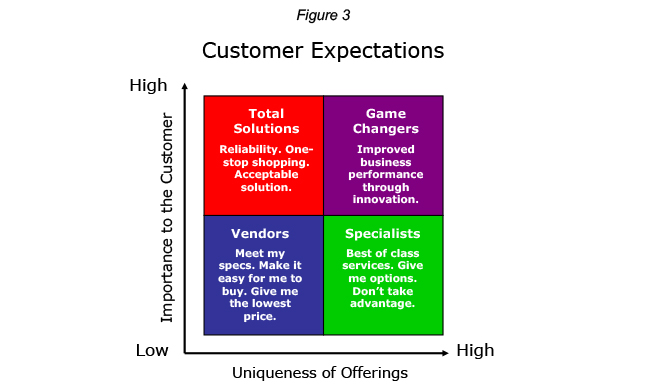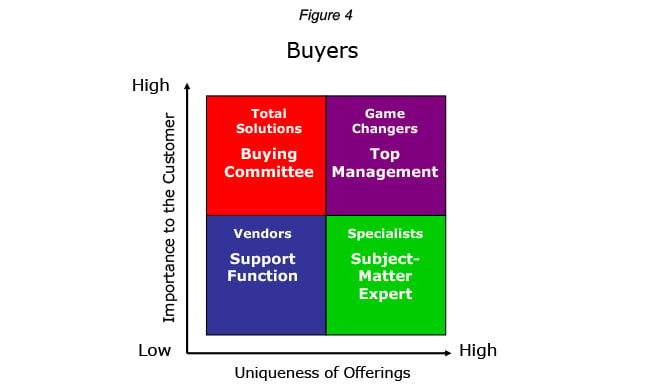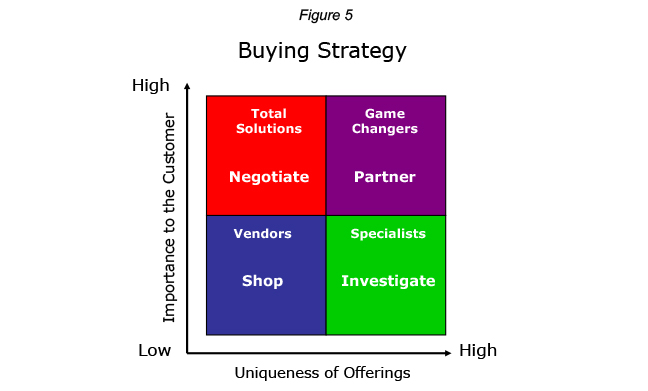No matter how talented your organization is, if you don’t have the right strategy, you’ll always suffer spotty customer satisfaction, fight problems with morale, and have to live with sub-par performance.
This two-part article will help you shape your strategy by better understanding how the customer perceives your organization and your competitors. Part 1 outlines:
- The four types of suppliers.
- The four value potentials.
- The customer expectations of each supplier type.
- The four types of buyers.
- The four buying strategies.
The Four Types of Suppliers
One of the simplest and most powerful ways to analyze strategy is by emphasizing two factors: (1) the importance of your portfolio of offerings to the customer, and (2) the uniqueness of your offerings in the marketplace. This outside-in approach forces an ongoing reality check and helps to minimize the myopia that often seems to set in when strategic planners and executives develop strategy without a constant and healthy dose of customer reality.
As an aside, I will wager that all your main customers would have no trouble quickly placing you and your main competitors in one of the four quadrants about to be described. So, to start with, it makes sense to ground our thinking in how customers view and classify suppliers.
Figure 1 shows suppliers classified by perceived importance and perceived uniqueness. The names I’ve chosen to represent these classifications help to quickly describe who they are: Vendor, Specialist, Total Solutions Provider, or Game Changer.

In which quadrant a customer places you has a direct relationship with how you will be viewed, how much time will be spent on you, how high up in the organization your offerings will be considered, and how much money you will be allowed to make. Obviously, this categorization is an important one. Four elements—value potential, expectations, who buys, and the buying strategy—help to shape the customer’s decision.
1. Value Potential
At the most basic level, customers perceive different value for each type of supplier (Figure 2). With low importance and low uniqueness, customers see little value in the offerings of Vendors. Specialists, however, provide services that are unique—usually not big-ticket items, but a special offering that is required, nonetheless. Hence, the value potential to the customer is medium. Select providers offer big-dollar, high-profile solutions (combinations of products and services), yet there are competitors that (the customer feels) can do the same thing equally well. Therefore, the offerings are not unique but important nonetheless, and are thus of high potential value to the customer. Game Changers are the few suppliers that possess highly unique offerings that are mission-critical to customers. The potential value of this relationship is extremely high to the customer, as successful implementation directly impacts his critical business issues.

2. Customer Expectations
The customer expectations we are interested in are the ones most important—the ones the customer will pay for (Figure 3).

Because of their low potential value, customers buying offerings from Vendors don’t want to spend much time or energy in the purchasing process—all they want is an offering of acceptable quality, one that is easy to buy, at a low price. All things being seen as equal, the lowest price always wins.
Because the Specialist has unique capabilities, the customer expects best-in-class offerings. Since there are very few (sometimes only one) suppliers that have this capability, the customer is always wary of being taken advantage of. Customers don’t mind paying a premium for these offerings (they have to have them), but they’re always concerned about not having the offerings available when they need them. Hence, the customer is always looking for other options to meet their specific needs.
When buying from a Total Solutions Provider, the purchase is high visibility (and high risk to the backers of the selected supplier). First on the list of expectations is reliability—the sign of assurance that the services provider can do what it says it will do. Next, the customer wants one-stop shopping, as many big, complex purchases involve many suppliers, and the customer wants one, and only one, organization to act as their agent to address the initiative. Finally, of course, the customer wants the solution to work, however (and although they will seldom admit it) they are not looking for the very best answers, otherwise they would have handpicked the team of diverse specialists required to do the job.
Customers expect only one thing from Game Changers—innovative answers that positively impact business performance and help them differentiate from their competitors.
3. Buyers
Although there may be influencers, sponsors, and users of supplier offerings, there is only one person (or group) tasked with making the actual purchase (Figure 4).

Purchasing from Vendors usually is delegated to a junior member of a support function, such as purchasing. Since the offerings of Vendors aren’t seen as important, it makes sense to give the responsibility to a lower-level person.
The buyers of Specialist offerings are often subject-matter experts who understand the intricacies and sophistication of these offerings and act to help determine requirements and rate performance.
Because of the size of the sale, the complexity of its implementation, and the breadth of functions its application impacts, a buying committee is the standard purchasing mechanism for purchasing total solutions. Usually headed by a department senior manager, the team typically is composed of cross-functional professionals and sponsored by an executive.
The buyers of the services of Game Changers can only be top management, because only this group is charged with strategic decisions. In most cases, this responsibility falls to the CEO.
4. Buying Strategy
The buying strategy is the organization’s philosophy on their approach to purchasing (Figure 5).*

When buying from Vendors, the buying strategy is always to shop around for the best deal. An important consideration here, though, is that not much time will be spent. Hence, a deal that looks good after only two or three comparisons may appear so due to not taking the time required for a thorough search.
When purchasing from Specialists, the buying strategy is to continually investigate other potential suppliers and substitute offerings.
When considering purchasing from Total Solutions Providers, there are always at least two or three suppliers that customers feel can do the job adequately. Since there are only minor areas of uniqueness, once the shortlist is finalized, the buying strategy is to negotiate—offer better terms, toss in a few more services, lower the cost a bit.
When the critical business issues of the organization are at stake, customers will aggressively try to partner with those they see as Game Changers, as they realize that organizations with these capabilities are few and far between. They will pay just about anything (within reason) to get the job done “world class.”
Out of One Box and into Another
That’s it. Like it or not, all your customers have put you in one of the four boxes along with your competitors. Do customers see you where you think you are? Sadly, often they do not. Unfairly pegged? Want to make a move? All is not lost! You can reinvent yourself. You can change their perceptions over time through smart marketing, focused communications, and innovative communication strategies that “tell your story” from a new and fresh perspective. It is a slow and deliberate process, but doable, nonetheless.
In my next article “Brilliant Strategy: Four Paths to Greatness – Part 2,” I will discuss the implications of the four supplier strategies required to deliver on customer perceptions and articulate:
- The four supplier strategies.
- The four value propositions.
- The drivers behind each strategy.
- The differentiators for each strategy.
- The metrics that matter.
Endnotes
*Adapted from Rethinking the Sales Force: Redefining Selling to Create and Capture Customer Value, by Neil Rackham and John De Vincentis. 1999. McGraw-Hill.
This post is modified from S-Business: Reinventing the Services Organization, by James A. Alexander and Mark Hordes. 2003. Alexander Consulting.



